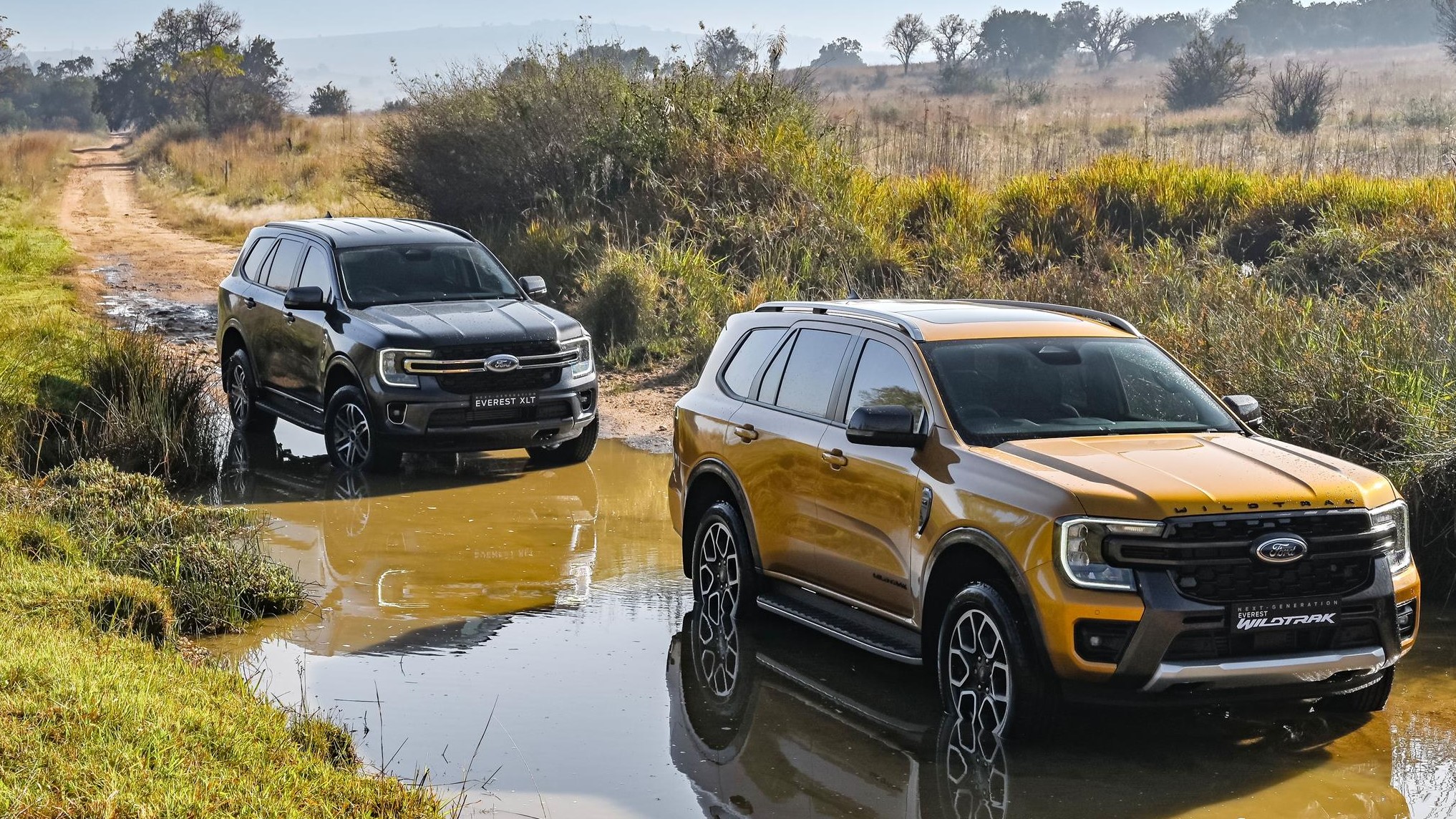WhatsApp’s 2025 update surge is in full motion and South Africa is once again at the front of the global test pool. With more…
Fortuner and Everest Buyer’s Guide 2024

Fortuner or Everest? It’s a question that many middle-class South Africans consider, when buying that ideal large family car.
South Africa is all about derbies and localized rivalries. A country of vast spaces and diverse communities, tribalism is a feature of South Africa, and it applies everywhere, even the choice of SUV.
With a national road network degrading by the day, and many families realising how healthy the mindful escapism fo a weekend away can be, South Africans have embraced the SUV as a family vehicle. And why not? Unlike Europe or the United States, there is an abundance of adventure venues where access is only possible with an SUV.

What are Everest and Fortuner for?
If you need a family vehicle capable of self-supported weeklong vacationing in the Namaqualand, Kalahari, Karoo, or Mozambique, it must be a bakkie-based SUV. And true to South Africa’s bakkie tribalism, there are two model which oppose each other, despite one selling in much greater volumes than the other.
It’s the five-door versions of Toyota’s Hilux and Ford’s Ranger: Fortuner versus Everest. With a slightly smaller range of derivatives, Everest doesn’t sell in nearly the numbers that Fortuner does but they are clearly rivals.
Ford’s marketing people will tell you that Everest is positioned as a value alternative to Prado and doesn’t compete with Fortuner. But that’s illogical and disingenuous, because it’s built on the Ranger bakkie platform and clearly rivals Fortuner. Prado, as part of the legendary Land-Cruiser range, is a vehicle unto its own and can’t be compared with Everest.
We’ve tested many of the latest Fortuner and Everest variants and the two model range’s have broad plusses and minuses, before one starts directly comparing features and price.

Design merits and debits
Regardless of the derivative you choose, Ford’s Everest is a very convincing design. It’s C-shaped headlights, that bold grille, contoured bonnet, simple proportions and clean surfaces create a very accomplished design.
Toyota’s Fortuner features less square proportions, especially around the nose, and although it’s a clean design, it can’t match the presence of Everest. Whether an SUV’s design has value for you in the school parking area, as a status statement, or projecting road presence when cruising in the far right hand lane of the N1, Everest has it. In abundance.
South Africa doesn’t have the same parking issues that many European and American cities do. Parts of Cape Town have narrow, colonial era streets, but most road and parking infrastructure is generous to the demands of a large SUV. That said, the Everest is a very big vehicle, being 109mm longer and an enormous 65mm wider than Fortuner.
If edging into the smallest parking bays is something you do often, even with its comprehensive sensors and cameras, the Everest requires more driver attention to avoid scratches or dings.

Cabin architecture
Ford’s futuristic design awareness isn’t limited to Everest’s exterior design. The cabin environment is very clever, with an inspired assortment of digital UX and traditional utility.
Although both Fortuner and Everest are seven-seater SUVs, the Ford has a far superior third-row seating system. Toyota’s seats 6 and 7 deploy from an upright position, where they are unlatched. Those seat fittings mean that you lose a lot of luggage space along the edges of the Fortuner’s load area, when they aren’t in use. It’s a legacy issue with Fortuner, and strangely, Toyota hasn’t addressed it.
The logic from Toyota HQ is that Fortuner’s third-row seating is removable, so if the luggage space intrusion bothers you, there’s the option to remote seats 6 and 7, and store them in your garage. But that logic is problematic because Everest proves that an integrated solution is available. With the Everest, its third-row seats submarine into the floor, when not in use. A more elegant and user-friendly solution.

Everest is bigger – and it shows
Large SUVs are often used to transport long objects, or for adventurers to sleep-in, when stealth camping in isolated rural areas.
Regarding cabin space utility, Everest again trumps Fortuner because it’s second and third-row seats can fold completely flat, with very little gap between. Why is that important? Well, if you’ve slept in an SUV, you know that the gap between second- and third-row seating, when folded flat, can be a very annoying and keep you awake as your legs keep ‘sinking’ into the gap.
Because the Fortuner’s third-row seats stow to the sides, in a latched-up position, you can’t ever hope to create a true bedding surface inside, unlike Everest, where its seats do make comfortable in-car sleeping very easy.

What about the UX?
Ford and Toyota’s bakkie-based SUVs might feature rugged steel chassis, with a ladder-frame construction, but all vehicle types require slick device integration. And these SUVs are no different.
Although Everest and Fortuner both offer touchscreen interfacing, Apple CarPlay, Android Auto, and rear-view cameras, the Ford UX is vastly superior. From graphics to menu logic, navigation and functionality, everything about integrating and charging your devices inside an Everest is much better than a Fortuner.

Fortuner versus Everest – screens
Ford’s MySync4 system is positioned as a large portrait view tablet, instead of Fortuner’s much smaller, lower contrast infotainment system. Everest also offers inductive charging, which Fortuner doesn’t.
Toyota fans will counter with the fact that Fortuner’s infotainment system has physical home and menu function buttons, framing either side of the screen. These are easier to operate when driving on rough dirt roads, or off-road, but the fact is that Ford’s infotainment system and integration, is better executed.

Fortuner and Everest engines
You have two engine options for both model ranges, with Ford offering a 2-litre bi-turbodiesel and 3-litre V6 turbodiesel, while Toyota’s Fortuner is powered by a 2.4-litre or 2.8-litre turbodiesel.
Ford offers more engine output than Toyota for its large SUVs, and where the Fortuner only has six-speed gearboxes, the Everest has ten.
Ford’s 2-litre boosts 157kW, versus Toyota’s 2.4-litre’s 110kW. The difference in performance is significant. It’s the same for the two larger powertrain options. Everet’s 3-litre V6 is rated at 184kW, with Fortuner’s 2.8-litre only having 150kW.

Ten speeds versus six
For long-distance cruising, the Everest engines are superior. They feel more responsive, as they should considering their power advantage and more available ratios.
Ford’s engines are refined and quiet at slower driving speeds around an urban commute. Fortuner’s six-speed automatic transmission feels a generation older than Everest’s ten-speed self-shifter, lacking the shifting smoothness of the Ford powertrain.
If engine outputs, powertrain characteristics and gearbox functions are things that influence your buying decision, Ford’s engine and transmission options do create a better driving experience for Everest, compared to Fortuner.

Which is better for adventure?
You can discuss the merits of UX, device integration, and seat comfort all you like, but a large SUV without true all-terrain ability is chocolate teapot.
If Everest is quieter, smoother and tracks more confidently at speed, on-road, does that advantage transfer off-road? There’s nothing dramatically different between Ford and Toyota’s SUVs regarding their off-road hardware. But model range’s have similar suspension designs (independent wishbones up front, semi-independent multilink at the rear), low-range on 4×4 versions, and rear-differential locks on all.
The digital driving aids, where you can select terrain appropriate engine mapping and transmission shift points, don’t really make that much of a difference. They’re a gimmick. The functions you need in challenging sand terrain, or steep rocky trails, is to control the gearbox shift points, have all electronic traction aids disabled, and a rear differential that is securely locked-up.
Although the Everest’s V6 turbodiesel engine option is very powerful, its advantages are limited in low-speed off-road work. The same applies to the Everest’s 10-speed automatic transmission – it’s wonderful in traffic or when cruising at highway speeds, but all those additional ratios don’t matter much for off-road work.

The off-road equation
Fortuner’s big advantage is that it offers a six-speed manual transmission option, which allows for complete control, a significant benefit in technical sand driving.
An automatic transmission is safer and easier for amateur off-road drivers to use, but for true control when navigating extreme off-road terrain, there’s no substitute for experience, driving skill, and a manual gearbox. This is something Toyota offers with Fortuner, but Ford doesn’t with Everest.
Ford and Toyota’s SUVs have similar ground clearance numbers of around 225mm, but for experienced 4×4 drivers the benefit of Fortuner’s manual gearbox options is real. It’s slightly smaller dimensions also trigger less damage anxiety when having to mauver around trees in bushveld conditions, or edging close to unevenly shaped rock walls, as you round hairpin corners on a severe mountain trail.

Neither have 17s
Tyres matter when using an SUV as an all-terrain adventure vehicle. The ideal wheel and tyre combination is having a small diameter of the former and a large sidewall (and air-volume) version of the latter.
For South African all-terrain driving and off-roading the ideal set-up is a 17-inch wheel, with a 60- or 65 profile sidewall. That allows a lot of air volume for bump absorption, and when you need to deflate tyres for sand driving, to elongate their contact patch and enhance traction, big sidewalls are very beneficial.
It’s a great pit that neither Everest of Fortuner offer a 17-inch wheel option, which are available on Ranger and Hilux bakkies’ which they were developed from.
The most off-road appropriate tyres Toyota offers on Fortuner are a 265/60, rolling on 18-inch wheels. Ford offers the same wheel size option, with a slightly narrower tyre option with more sidewall on Everest: 255/65.

The pricing issue
If you value in-car space, UX design, overtaking performance and long-distance driving comfort the choice must be Everest. ‘But which one?’ Best buy in the range, now, is the XLT 4X2, at…
Fortuner might be slightly less sophisticated and refined than Everest, but its ruggedness is indisputable. For true off-road adventuring the Fortuner’s annual gearbox option makes it the superior choice. And when you compare the two model range’s, there is a pricing advantage with Toyota’s offering.
The most affordable Fortuner starts at R673 100, with the 2.4 GD6 RB 4×2 manual. Ford’s entry-level Everest, the 2.0L XLT 4×2 prices at R899 000. For the near as makes no difference the price of Ford’s most affordable Everest, you can buy a Fortuner 2.8 GD6 4×4 auto (priced at R901 700).
There are no less than seven trims and grades of Fortuner, that undercut the Everest’s price floor. And yes, the Ford is larger, with a most sophisticated engine, gearbox and added features, but Toyota’s ability to market Fortuner in that crucial R700 000 to R850 000 range, is notable.
The pricing benefit of Fortuner versus Everest is compounded by Ford’s absence of a service or maintenance plan. When buying an Everest you need to purchase an eight year/165 000km service plan, as an addition cost. With Fortuner, there is a 90 000km service plan, tallying nine services, included in the price.


